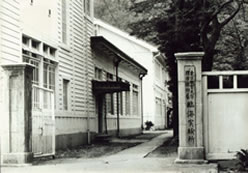History of the center
In 1932 (Showa 7), by courtesy of Shimoda Town (at that time), we received a donation of about 18,200 square meters of land, and almost at the same time as the government system was established in June 1933 (Showa 8), the laboratory, aquarium, and buildings such as the specimen room and a dormitory were completed and the Tokyo University of Literature and Science Marine Research Station was established here. In 1949 (Showa 24), the name was changed to the Marine Research Station attached to the Faculty of Science, Tokyo University of Education, and in 1976 (Showa 51), it was renamed to the Shimoda Marine Research Experiment Center, University of Tsukuba.
At the time of its founding, all the buildings were made of wood, but in 1968 (Showa 43) it was rebuilt into three reinforced concrete buildings, and further expanded in 1975 (Showa 50), 1979 (Showa 54), and 2010 (Showa 54). In March 2010, the 3rd research building was expanded. Since its establishment, the Shimoda Marine Research Center has achieved remarkable results in phylogenetic research on horseshoe crabs, research on self-non-self-recognition of colonial ascidians, and physiological and ecological research on marine algae. It has also contributed to education as a place for training and running field courses for many universities, including the University of Tsukuba.
